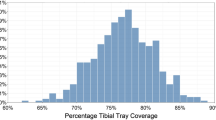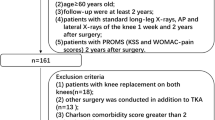Abstract
Purpose
Numerous studies demonstrated that prosthetic overhang and over-sizing cause pain and stiffness following total knee arthroplasty (TKA), but none considered volume changes within the joint capsule. This study was designed to investigate differences in volumes of resected bone compared to implanted components in TKA, and to determine the incidence and factors related to ‘over-voluming’.
Methods
Three-dimensional reconstructions were created from 100 magnetic resonance imaging scans taken to design patient-specific instruments for TKA. The preoperative simulations were used to calculate the volume ratio (VR) by dividing volume of planned components by that of planned bone resections. Uni- and multi-variable linear regressions were performed to determine associations between ‘over-voluming’ (VR > 1.0) and gender, implant size and version (standard versus narrow), osteophytes, resection levels, external rotation of the femoral component, hip–knee–ankle (HKA) angle, mechanical lateral distal femoral angle (mLDFA), and mechanical medial proximal tibial angle (mMPTA).
Results
The overall implant/bone volume ratio was 0.91 ± 0.11 (range 0.63–1.16) with ‘over-voluming’ observed in 24 knees. Multi-variable regression confirmed over-voluming to be associated with lower mLDFA (OR 0.66; CI 0.45–0.93; p = 0.026) and extensive osteophytes (OR 0.14; CI 0.03–0.61; p = 0.014), but not HKA angle (OR 0.98; CI 0.76–1.26; p = n.s.).
Conclusions
Over-voluming was observed in 24% of knees, in which the implant volume exceeded the resected volume by up to 16%. Over-voluming was associated with intra-articular femoral valgus (low mLDFA), but not directly associated with tibial deformity (mMPTA) or HKA angle. Over-voluming could be associated with prosthetic overhang or excessive tensions within the joint capsule, and, therefore, contribute to unexplained pain and stiffness following TKA.
Level of evidence
IV, Retrospective cohort study.



Similar content being viewed by others
References
Barrett DS, Cobb AG, Bentley G (1991) Joint proprioception in normal, osteoarthritic and replaced knees. J Bone Jt Surg Br 73(1):53–56
Bonnin MP, de Kok A, Verstraete M, Van Hoof T, Van Der Straten C, Saffarini M, Victor J (2017) Popliteus impingement after TKA may occur with well-sized prostheses. Knee Surg Sports Traumatol Arthrosc 25(6):1720–1730
Bonnin MP, Saffarini M, Bossard N, Dantony E, Victor J (2016) Morphometric analysis of the distal femur in total knee arthroplasty and native knees. Bone Jt J 98-b(1):49–57
Bonnin MP, Saffarini M, Nover L, van der Maas J, Haeberle C, Hannink G, Victor J (2017) External rotation of the femoral component increases asymmetry of the posterior condyles. Bone Jt J 99-b(7):894–903
Bonnin MP, Saffarini M, Shepherd D, Bossard N, Dantony E (2016) Oversizing the tibial component in TKAs: incidence, consequences and risk factors. Knee Surg Sports Traumatol Arthrosc 24(8):2532–2540
Bonnin MP, Schmidt A, Basiglini L, Bossard N, Dantony E (2013) Mediolateral oversizing influences pain, function, and flexion after TKA. Knee Surg Sports Traumatol Arthrosc 21(10):2314–2324
Eberbach H, Mehl J, Feucht MJ, Bode G, Sudkamp NP, Niemeyer P (2017) Geometry of the valgus knee: contradicting the dogma of a femoral-based deformity. Am J Sports Med 45(4):909–914
Gibon E, Goodman MJ, Goodman SB (2017) Patient satisfaction after total knee arthroplasty: a realistic or imaginary goal? Orthop Clin N Am 48(4):421–431
Gibon E, Mouton A, Passeron D, Le Strat V, Graff W, Marmor S (2014) Doctor, what does my knee arthroplasty weigh? J Arthroplasty 29(11):2091–2094
Gunaratne R, Pratt DN, Banda J, Fick DP, Khan RJK, Robertson BW (2017) Patient dissatisfaction following total knee arthroplasty: a systematic review of the literature. J Arthroplasty 32(12):3854–3860
Hatayama K, Terauchi M, Saito K, Higuchi H (2017) Does residual varus alignment cause increasing varus laxity at a minimum of five years after total knee arthroplasty? J Arthroplasty 32(6):1808–1813
Heyse TJ, Decking R, Davis J, Boettner F, Laskin RS (2009) Varus gonarthrosis predisposes to varus malalignment in TKA. HSS J 5(2):143–148
Kawahara S, Matsuda S, Fukagawa S, Mitsuyasu H, Nakahara H, Higaki H, Shimoto T, Iwamoto Y (2012) Upsizing the femoral component increases patellofemoral contact force in total knee replacement. J Bone Jt Surg Br 94(1):56–61
Kellgren JH, Lawrence JS (1957) Radiological assessment of osteo-arthrosis. Ann Rheum Dis 16(4):494–502
Kohn MD, Sassoon AA, Fernando ND (2016) Classifications in brief: Kellgren–Lawrence classification of osteoarthritis. Clin Orthop Relat Res 474(8):1886–1893
Le DH, Goodman SB, Maloney WJ, Huddleston JI (2014) Current modes of failure in TKA: infection, instability, and stiffness predominate. Clin Orthop Relat Res 472(7):2197–2200
Lombardi AV Jr, Berend KR, Adams JB (2014) Why knee replacements fail in 2013: patient, surgeon, or implant? Bone Jt J 96-b(11 Supple A):101–104
Magnussen RA, Weppe F, Demey G, Servien E, Lustig S (2011) Residual varus alignment does not compromise results of TKAs in patients with preoperative varus. Clin Orthop Relat Res 469(12):3443–3450
Mahoney OM, Kinsey T (2010) Overhang of the femoral component in total knee arthroplasty: risk factors and clinical consequences. J Bone Jt Surg Am 92(5):1115–1121
Manrique J, Gomez MM, Parvizi J (2015) Stiffness after total knee arthroplasty. J Knee Surg 28(2):119–126
Meneghini RM, Grant TW, Ishmael MK, Ziemba-Davis M (2017) Leaving residual varus alignment after total knee arthroplasty does not improve patient outcomes. J Arthroplasty 32(9s):S171–S176
Mihalko W, Fishkin Z, Krackow K (2006) Patellofemoral overstuff and its relationship to flexion after total knee arthroplasty. Clin Orthop Relat Res 449:283–287
Nishida K, Matsumoto T, Takayama K, Ishida K, Nakano N, Matsushita T, Kuroda R, Kurosaka M (2017) Remaining mild varus limb alignment leads to better clinical outcome in total knee arthroplasty for varus osteoarthritis. Knee Surg Sports Traumatol Arthrosc 25(11):3488–3494
Paley D, Herzenberg JE, Tetsworth K, McKie J, Bhave A (1994) Deformity planning for frontal and sagittal plane corrective osteotomies. Orthop Clin N Am 25(3):425–465
Pugh L, Ruel A, Lipman J, Wright T, Gessell M, Westrich G (2013) Reduction in bone volume resection with a newer posterior stabilized total knee arthroplasty design. HSS J 9(2):157–160
Seah RB, Lim WSR, Lo NN, Yew AKS, Chong HC, Yeo SJ (2017) Unexplained pain post total knee arthroplasty with an oxford knee score>/=20 at 6 months predicts good 2-year outcome. J Arthroplasty 32(3):807–810
Sorin G, Pasquier G, Drumez E, Arnould A, Migaud H, Putman S (2016) Reproducibility of digital measurements of lower-limb deformity on plain radiographs and agreement with CT measurements. Orthop Traumatol Surg Res 102(4):423–428
Vanlommel L, Vanlommel J, Claes S, Bellemans J (2013) Slight undercorrection following total knee arthroplasty results in superior clinical outcomes in varus knees. Knee Surg Sports Traumatol Arthrosc 21(10):2325–2330
Zaffagnini S, Bignozzi S, Saffarini M, Colle F, Sharma B, Kinov PS, Marcacci M, Dejour D (2014) Comparison of stability and kinematics of the natural knee versus a PS TKA with a ‘third condyle’. Knee Surg Sports Traumatol Arthrosc 22(8):1778–1785
Acknowledgements
The authors are grateful to Mr. Toufik Zakaria for his assistance with data collection and interpretation of findings, to Ms. Marine Rachail for assistance with the preliminary statistical analyses, to Mr. Luca Nover for performing the final statistical analyses, and to Mr. Antoine Barnaud for producing illustrations (Fig. 5).
Funding
This study was funded by Corin-Tornier SAS (Montbonnont, France).
Author information
Authors and Affiliations
Contributions
SM participated in study design, data collection, and manuscript editing. ER participated in study design, data collection, and manuscript editing. JV participated in literature review, statistical analysis, and manuscript writing. MS participated in statistical analysis and manuscript writing. All authors read and approved the final manuscript.
Corresponding author
Ethics declarations
Conflict of interest
SM received fees for consulting and education from Corin-Tornier (France) and DePuy Synthes (France). ER is employee of Employee of Corin-Tornier (France). JV and MS received fees for support in study design and manuscript preparation from ReSurg SA (Switzerland).
Ethical approval
All procedures performed in studies involving human participants were in accordance with the ethical standards of the institutional and/or national research committee and with the 1964 Helsinki declaration and its later amendments or comparable ethical standards.
Informed consent
For this type of study formal consent is not required.
Rights and permissions
About this article
Cite this article
Marmor, S., Renault, E., Valluy, J. et al. Over-voluming predicted by pre-operative planning in 24% of total knee arthroplasty. Knee Surg Sports Traumatol Arthrosc 27, 1544–1551 (2019). https://doi.org/10.1007/s00167-018-4998-z
Received:
Accepted:
Published:
Issue Date:
DOI: https://doi.org/10.1007/s00167-018-4998-z




